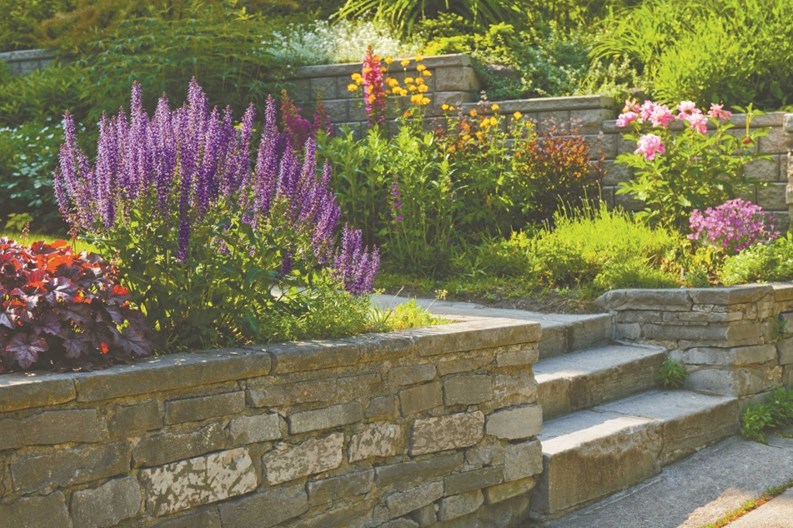Whether you live in a towering high-rise or a sprawling suburban development, landscaping not only helps a condo or HOA increase and retain property values, but has a positive impact on residents themselves—beautiful, functional green spaces and plantings increase pride of ownership, influence morale, and just generally make a place more pleasant to be in for owners and visitors alike. And unless there happens to be a master gardener or landscape architect on a building board or grounds committee, chances are that the community's administrators will have to call upon a professional landscape specialist to help make the most of their building's potential.
“A lot of people are very passionate about it, and it’s very subjective when it comes to what’s beautiful and what’s not, but it creates curb appeal. A lot of property owners depend on really creative landscape design and maintenance to attract and keep renters and associations to attract buyers,” says Robert Milani, senior landscape architect at Chalet Landscapes in Wilmette. Landscape designers also keep in mind a level of continuity, so the landscape reflects the cohesiveness of an association's property, whether everybody gets along perfectly or not.
Before You Make the Call
Everyone agrees a nice landscape is a positive thing for an association, but it's important to consider when to hire a landscape designer, and have an idea of what's needed. For condos and HOA's, it's either, maybe a dated landscape, or a poor design that's in place. For those without gardening or landscape experience simple factors of location and environment determine what plants can thrive where. It's' going to depend on what kind of area it is. “Is the area irrigated? How much traffic does the area see? The way the buildings face play a huge role, the soil, does it have good drainage, is it a shady area, does it have full sun?” says Sherm Fields, regional vice president of Acres Group in Plainfield. “Some plants are shade tolerant. There's a much larger palette of plants that do well in the sun, or at least partial. But, shade dramatically changes what kind of plants you can use,” he says. High traffic areas bring salt and other harsher chemicals onto nearby plants, so the knowledgeable designer will choose plants that tolerate salt well. There are a lot of factors that go into what are the best plants to use, and where, but good landscape architects and designers know them like the backs of their hands, and so long as the professionals can assess a property well, implementation doesn't require much guess work.
With the terrain in mind, landscape designers will tell associations that they need to have an idea of what purpose they want a landscape to serve. “The association should trust their contractors to do the highest and best use of the budget possible,” says Fields. If an association gets suspicious of a big price tag they can always get a second opinion.
But, in general, the budget determines a lot about the parameters of a project, as far as what can be done and what can't. “It's very difficult to do the work without a budget expectation in mind,” says Fields. If associations don't have experience with landscape design they can consult with designers to get an idea of what they're looking for. “They need to address functionality and what they want the particular space to do for them, and what’s the image they want to convey. What is the community actually going to do with that space? Is it going to be an outdoor space that people actually utilize or recreate in? Or are we trying to generate curb appeal, maybe for an entrance?” says Fields.
Especially for those who have not ever worked with a landscape designer, simply finding the right one can be stressful. Part of the reason is because pricing can be difficult. Much of the cost of a project depends on what materials will be used, and how much labor is required. For that reason, competitive bidding can be tricky because the lower bid might not be fulfilling everything asked for in the plan. “The property manager will normally have several landscape contractors that he or she works with. Some of those contractors will have more extensive design capabilities than others. So I would think the managers would lean on those professionals for the scope and thoughts about the project. Maybe take interviews from the association's board of directors on what their thoughts are on what should be done,” says Fields.
The Lawn Haul
Most associations in the Chicago area tend to be pretty well-maintained, but maybe the current lawn and those few trees just aren't cutting it anymore, or maybe they're not doing as well, or maybe the soil is starting to face drainage issues. Once associations and designers are in agreement on what the intended use is, careful planning should follow. “Normally, there's the idea that something should be done in a particular area of the property. Then you have to build a budget for that, and a lot of times it takes an association a couple years to do that. And then allow companies to submit designs, and fine tune those designs, and once that's all approved then it's a go,” says Fields.
Understandably, associations want their landscape designs to be easily noticeable. “Associations look for seasonal color, and plants that require less water and fertilization, things that don’t have to be pruned every other week, so we try to accommodate that,” says Milani. “In condos, we use things like shrub roses that flower from mid-May to late November, that don’t need to be pruned by flower continually. We use a lot of annual plantings that give you a lot of color, in entrance areas.” The level maintenance required for plants also plays a large deciding factor. One plant might not cost much to install, but if it grows fast and needs to be pruned often, for instance, the labor costs needed to keep the landscape looking tip-top will dwarf the initial costs. “Everybody wants plants that have easy maintenance,” says Fields.
The Green of Green Lawns
Landscape professionals are also concerned with larger questions, things like sustainability, and are able to take cues from a perspective that’s larger than the property lines of the site where work is to be done. Using plants native to the area can make an association's landscape much healthier and durable. “They grow up here, they're made for these soils. They're already accommodated to the particular area. Many times they can weather pests and diseases a lot better too,” says Fields. Climate change has also recently changed what plants can thrive in the area. “We’ve seen a trend over a period of 5 to 10 years. The hardiness zone has gone up half a degree, and it’s expanded our planting talent that are normally not hardy in our area. It’s allowing us to use more plants in landscapes,” says Milani.
Environmentally-friendly practices don't just deal with what materials to use, it also involves practices and maintenance. “As far as sustainability, utilizing rain water is huge,” says Fields. New design techniques try to minimize the amount of water run off on properties, which just end up in the sewers. Some landscape architects now try to create a slight bowl so water stays and permeates into the ground, which helps the soil and plants, and cuts down on the need for watering.
Some environmental factors are a hindrance to landscapes. In areas with more undeveloped land, deer and other animals become a big problem for plants. “We deal with things like deer and rodent damage often, especially in the winter months, and there’s a lot of snow cover and they can’t find food, so they go to plants,” says Milani. For communities that come up against the problem on a regular basis need to consider plants that are not favored by deer and other critters.
Timing It Right
Condo boards tend to make decisions on their own time, but timing can play an important factor in whether a project gets done in the same year it began. “You can design 12 months out of the year, usually installs don't start until the weather breaks in the spring, usually until November if the weather holds,” says Fields.
Local city and town codes are a factor that boards and associations definitely need to be aware of. The city of Chicago requires fairly strict permitting for most landscape projects that are adding new plants, and affecting irrigation or drainage, But, outside the city, town codes tend to be somewhat less stringent, but codes should need to be considered. “There’s restrictions on height of plant material on corners of streets. There’s an approved list of trees species that we have to follow. Some towns including Chicago, we have to submit a landscape plan for a particular development,” says Milani. “Drainage always has to be approved by the village and permitted. Pavement, sidewalks driveways. All of that kind of plays hand in hand. There’s always a lot of requirements with permitting with anything that deals with safety issues,” says Milani.
Landscape design can be a huge investment. But, it's not a needless detail. A well thought out design can enhance more aspects of home life than just the property value. In a uncertain real estate market, a beautiful landscape can keep values up when there's more competition in the market than usual. But ultimately, the returns come back when residents use the space as “an outdoor room,” says Milani. “To me it’s primarily aesthetics. Of just people enjoying outdoor landscapes,” he says.
Denton Tarver is a freelance writer and a frequent contributor to The Chicagoland Cooperator. Editorial assistant Tom Lisi also contributed to this article.





Leave a Comment